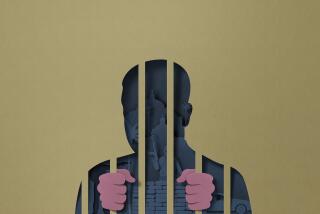He vanished in ’75 into the Twilight Zone of legend. Now, new tales are casting a more sympathetic light on . . . : The Immortal Hoffa
- Share via
Things are finally looking up for Jimmy Hoffa.
You remember the story. He took a meeting in 1975 and never came back, vanishing from the parking lot of a suburban Detroit restaurant in the company of bad fellas. Next stop, the Twilight Zone of American legend, a macabre universe somewhere on the dark side of Elvis.
In this new dimension, the tough former Teamsters boss has been immortal for 17 years, his ghost kept on life support by sick jokes on late-night TV, a trickle of books and periodic claims that someone has finally, absolutely and irrevocably solved the most famous disappearance since Amelia Earhart flew into a historical black hole in 1937. (Both Hoffa and Earhart disappeared in the month of July. Cosmic coincidence or mind-boggling conspiracy from outer space?)
In fact, Hoffa’s afterlife in the popular imagination has been a kind of flip side of Elvis, undisputed King of the Famous Dead. Unlike Elvis, Hoffa’s body has never been found, but legions of wishful fans never claim that they saw Hoffa alive and happily anonymous, perhaps as Elvis’ valet and bodyguard. Likewise, Hoffa statuettes, T-shirts and commemorative plates cannot be found anywhere, at any price.
Still, this is a country where every legend and myth inevitably is recycled, and Hoffa’s lowly status in celebrity hell may soon change.
Within the last year, newspaper articles and a new scholarly biography have portrayed the former Teamsters chief in a more sympathetic light, arguing that ex-con Hoffa was more than a hapless target of a Mafia hit, more than a corrupt, on-the-make, power-hungry sleazeball who had the bad taste to wear white socks with his suits.
“He was a hero and a villain. He was bigger than life,” says Arthur A. Sloane, a University of Delaware industrial relations professor whose 1991 biography “Hoffa” is being issued in paperback by the MIT Press.
This Saturday, Hoffa will be a figure in an HBO movie, “Teamster Boss: the Jackie Presser Story,” about another ill-fated Teamsters president who died of brain cancer before the Mafia might have killed him, too. (Presser’s life rivaled Hoffa’s for Byzantine intrigue. He had five wives and informed for both the FBI and the Mafia.)
Meanwhile, Michael Korda’s new novel, “The Immortals,” features Hoffa and the Teamsters pitted against John and Robert Kennedy and Marilyn Monroe.
And by year’s end, the reconsideration of Hoffa promises to take on starship momentum with the release of a movie starring Jack Nicholson as the maligned union leader.
While none of this is likely to elevate Hoffa to sainthood, it may bestow a blessing of sorts, restoring the complexity of a man who loved luxury and dealt with gangsters but had an “intuitive” Marxist view of capitalism, according to a 1965 biography. “Hoffa,” the movie, reputedly will be a Hoffa booster, portraying the union leader as a man smeared by the U.S. government. Some predict it will set off a feeding frenzy of me-too programming.
Before this burst of attention, Hoffa’s continuing fame rested largely on speculating about--and joking about--where his mortal remains might be--often in a place associated with large batches of cement. (Standard Hoffa joke: A Teamsters’ official dedicating a new union hall declares, “Jimmy Hoffa will always be a cornerstone of this building.”)
Hardly anyone believes Hoffa is alive because in his final days, he was fighting to return to power in the Teamsters, whose huge cash assets had become a slush pool for needy gangsters. The conflict pitted Hoffa against shady characters with nicknames like “Tony Pro” and “Sally Bugs.”
Various accounts of Hoffa’s demise place his gruesomely dismembered body under a freeway, a highway maintenance garage, a cornfield; stuffed in an oil drum; dumped in a swamp, or reduced to smoke, soot and ashes in an incinerator.
Three years ago, Playboy magazine gave the nation a laughing fit when it printed a mobster’s tale that Hoffa had been buried in the “coffin corner” of the Meadowlands, where the New York Giants play football. By this account, the killers chopped Hoffa into pieces, stuffed the parts into plastic bags and then sent out to a deli for meatball sandwiches and soft drinks.
As recently as July (that month again!), an anonymous mobster confessed on tabloid TV that he and accomplices whacked Hoffa and dumped his body in Lake Michigan, a claim that can never be tested until somebody figures out how to talk to fish--old fish at that.
Appearing on “A Current Affair,” the ex-con claimed that he was dying of emphysema and wanted to “set the record straight” before he joined Hoffa in the Great Unknown. According to the unnamed hit man’s story, he and three other men dragged the 62-year-old Hoffa outside the Machus Red Fox restaurant. The killers threw Hoffa into a van, drugged him and drove to Chicago, where they boarded a yacht and sailed into the middle of the lake. There, the unconscious Hoffa was weighted down and tossed overboard.
Also in July, Antonio (Fat Tony) Salerno suffered the last of a series of strokes while he languished in federal prison. The 80-year-old New York mobster, doing 100 years for racketeering, once had been fingered--albeit in the lightly regarded Playboy account--as the big cheese who ordered Hoffa’s death. Perhaps significantly, Salerno also had been convicted in a bid-rigging scheme that affected virtually every high-rise building in New York using substantial amounts of concrete .
Unfortunately, the man widely regarded as the most likely engineer of Hoffa’s murder never was inclined to talk. And now he can’t, unless he makes contact through a seance. Anthony (Tony Pro) Provenzano died of heart failure in 1988 while serving a 20-year sentence at the federal prison in Lompoc. Hoffa and Provenzano had done time together in another federal prison, where the two had quarreled. The day Hoffa vanished, he was supposedly on his way to Detroit for a reconciliation meeting with Provenzano, president of a new Jersey Teamsters local. But Provenzano was conspicuously in New Jersey that day, hard at work on an alibi.
Before Tony Pro, Hoffa’s chief nemesis was Robert F. Kennedy, who as a counsel for a Senate committee and as U.S. attorney general relentlessly pursued Hoffa. During his 10 years as Teamsters chief (1957-1967), Hoffa was investigated numerous times by the feds before he was finally nailed on jury-tampering, fraud and conspiracy charges. He served nearly five years of a 13-year term in federal prison before his sentence was commuted by President Nixon in 1971.
“When the Kennedy Administration was trying to put Hoffa in jail, Hoffa had a lot of sympathy,” recalls W. David Slawson, a USC law professor who served on the Warren Commission. “He got kind of a Jesse James or John Dillinger aura about him.”
Meanwhile, biographer Sloane’s experience is testimony to the enduring quality of the Hoffa mystique. For years, Sloane lectured about Hoffa a couple of times each semester because of students’ curiosity. About five years ago, he gave an interview to the student newspaper at the University of Delaware, where he teaches. In that interview, Sloane noted that he had known Hoffa. When Sloane was a graduate student in the 1960s, the Teamsters head had allowed Sloane to spend four months following him around the country, doing research for a dissertation.
When the story appeared, Sloane was surprised at the response. People were impressed that he had known Hoffa and interested in anecdotes about him. Sloane decided there was a book in it.
The result is a biography that is perhaps more moderate than many other works about Hoffa. Sloane’s verdict is that Hoffa was “a very good union leader” who could “deliver the goods” to the union membership.
During Hoffa’s tenure, the Teamsters grew into arguably the nation’s most powerful union, branching out from its base of truck drivers and warehousemen into other trades. Membership peaked in 1978 at 2.2. million but has now declined to about 1.6 million. The union exerted clout with campaign contributions and made alliances with Presidents.
But Sloane gives Hoffa an F as a citizen because he was “a close friend of big-league gangsters.”
Indeed, if there is a central debate about Hoffa’s legacy, it is about how mobbed up he was. His family has argued for years that the gangster connection has been exaggerated and has contended that Hoffa would have thrown the mob out of the union if he had regained power. Hoffa’s detractors differ, portraying him as a man so compromised he could never come clean.
Again, Sloane falls in the middle: “He could say no to the mob as well as yes to the mob.”
Undeniably, the gangster element is the darkest and most convoluted chapter of the Hoffa story. According to most accounts, gangsters got a foothold in the Teamsters in the 1930s, when the union turned to the mob for protection during heated organizing battles. Once entrenched, the mob didn’t let go. Teamsters’ pension money became a trough at which many marginal characters fed. As a result, the union had a piece of many casinos, resort hotels and other investments not recommended for widows and orphans.
Through his mob connections, Hoffa also has been linked to the CIA and to a conspiracy to kill President Kennedy. Indeed, one theory is that Hoffa was rubbed out because he might have revealed details of a CIA plot to have the Mafia assassinate Cuban dictator Fidel Castro.
This conjecture was advanced by, among others, one William E. Bufalino Sr., a lawyer and former close Hoffa associate who ended up representing men questioned in connection with Hoffa’s disappearance. Bufalino died two years ago of leukemia, one of a relative few former Hoffa associates to die peacefully or outside prison.
Earlier this year, another former Hoffa lawyer, Frank Ragano, placed Hoffa at the heart of the “crime of the century.” In at least two TV appearances, Ragano alleged that in early 1963, Hoffa had him tell two Mafia kingpins that Hoffa wanted President Kennedy killed.
While these theories are not given much credence, they illustrate how boldly Hoffa once strode across the American stage. He battled the Kennedys, built the biggest union in the United States, hobnobbed with dangerous men and seemed never to regret who he was or how he had gotten there.
Perhaps the biggest mystery isn’t where Hoffa is buried but why he wasn’t rediscovered before now. As Sloane noted, Hoffa’s life never has been put on film, despite being a natural for the Hollywood treatment.
But even though he “hit it off” with Hoffa, Sloane still regards the man with ambivalence. He remains appalled by Hoffa’s “ferocious temper,” explaining that Hoffa once tongue-lashed a subordinate so viciously that “the guy collapsed of a heart attack.”
In fact, Hoffa may be eternally cursed by the conflicting memories of those who knew him.
One source told Abby Mann, executive producer and writer of the HBO Teamsters movie, that Hoffa “had the most beautiful smile I ever saw.”
In a transcript of a conversation with Mann, the former Hoffa associate added, however, that his infatuation with Hoffa eventually went as sour as a failed teen-age romance.
“He really was a deep-down hood,” the former associate said. “And that’s why he got killed. . . . Because he became one of them and didn’t think they would put the hit on him. He became one of them and didn’t think he’d be touched.”
More to Read
Sign up for our Book Club newsletter
Get the latest news, events and more from the Los Angeles Times Book Club, and help us get L.A. reading and talking.
You may occasionally receive promotional content from the Los Angeles Times.








